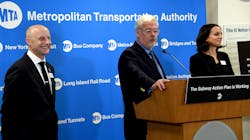MTA subway performance hits bar it hasn’t seen in nearly six years
Metropolitan Transportation Authority (MTA) subway on-time performance reached 81.5 percent in June, which is the first time the statistic has climbed above 80 percent in nearly six years. MTA leadership including Chairman and CEO Patrick Foye, New York City Transit President Andy Byford and Senior Vice President, Department of Subways Sally Librera outlined the improvements on July 11.
To provide perspective, only 18 months ago, weekday on-time performance dropped to an all-time low of 58 percent. MTA credited the statistical performance improvements to continued efforts surrounding the Subway Action Plan (SAP), launched in July 2017 and the Save Safe Seconds campaign, which launched in December 2018. MTA explains that the SAP has provided a surge of additional union personnel, outside contractors and new tools and methods for the maintaining and improving the system.
MTA says that on-time performance has continued to improve and major incidents have declined to the lowest number since this record has been kept, and other customer-centric performance numbers are also pointing higher. The authority says overall subway performance continued its steady improvement in June 2019, with every weekday metric better than both June 2018 and the average of the past 12 months.
“More than six months of sustained improvements show that our sSubways team’s emphasis on the basics of service and our push to make strategic, institutional changes at every level through the Subway Action Plan is getting solid results that we are proud of,” said MTA Chairman Patrick Foye. “And, with the passage of Central Business District Tolling through the leadership of Governor Cuomo, the best is yet to come.”
In addition to weekday on-time performance reaching its highest level since August 2013, weekday major incident decreased 27.4 percent from June 2018 and weekday train delays decreased 45.9 percent from the same time period in 2018 and represents the lowest level of delays since September 2013.
MTA notes that a contributing factor to the reduction in delays has been the significant progress made in reducing track debris fires, which are significantly down since NYC Transit began using new equipment to address the problem in 2017. MTA says the platform-based mobile vacs and vacuum trains have allowed debris to be cleared at an unprecedented rate. Year to date, track fires are down 61 from 185 to 124, and they are down 130 for the previous 12 months, from 410 to 280.
Positive numbers were also realized in many of NYC Transit’s customer-focused metrics, including Service Delivered, Additional Platform Time, Additional Train Time, and Customer Journey Time Performance, as all metrics were better than one year ago and better than their average performance over the past 12 months.
“Running a subway requires people with the right skills, the right mandate and the right focus to identify and eliminate root causes of delay,” said New York City Transit President Andy Byford. “I asked Sally and her team to focus on getting the basics right and to develop a campaign to complement the work already under way via the Subway Action Plan. Working with our union partners, our Save Safe Seconds campaign has safely speeded up service across the network with more improvements still to come.”
SAP by the numbers
During the Subway Action Plan, MTA teams and outside contractors have:
• Cleared more than 55,000 street grates to prevent ingress of litter and leaves that build up on the track, causing fires and clogging drains;
• Sealed more than 6,300 leaks to prevent water ingress that causes power and signal problems, deterioration of track and other equipment resulting in unplanned service changes, delays and track fires;
• Installed 51 miles of Continuous Welded Rail (CWR) across the system, replacing jointed rail, which is more prone to rail defects that delay trains;
• Repaired almost 25,000 minor track defects that if not repaired can cause delays;
• Performed 79 miles of track rail grinding to improve ride quality and reduce defects;
• Repaired or rebuilt more than 1,700 signal components, drastically reducing the backlog of issues that can disrupt service;
• Completed 1,200 priority maintenance and repair tasks to improve reliability of signal and switch equipment;
• Rebuilt and modernized more than 300 signal stops to be moisture proof and avoid service interruption;
• Conducted a comprehensive inspection of door components across all fleets;
• Made maintenance practices more efficient so cars can be put back into service more quickly;
• Repaired door control units on over 1,000 cars in our oldest fleets to improve reliability of this critical component that cause 40 percent of car breakdowns;
• Overhauled more than 2,600 cars in an accelerated major car overhaul program, where the overhaul cycle changed from seven years to six years;
• Conducted a deep cleaning initiative of over 2,500 car interiors and over 2,700 car exteriors;
• Conducted a deep cleaning initiative of over 100 subway stations; and
• Enhanced 130 stations via a focused cleaning and repair campaign led by Group Station Managers.
Source: Metropolitan Transportation Authority

Mischa Wanek-Libman | Group Editorial Director
Mischa Wanek-Libman is director of communications with Transdev North America. She has more than 20 years of experience working in the transportation industry covering construction projects, engineering challenges, transit and rail operations and best practices.
Wanek-Libman has held top editorial positions at freight rail and public transportation business-to-business publications including as editor-in-chief and editorial director of Mass Transit from 2018-2024. She has been recognized for editorial excellence through her individual work, as well as for collaborative content.
She is an active member of the American Public Transportation Association's Marketing and Communications Committee and served 14 years as a Board Observer on the National Railroad Construction and Maintenance Association (NRC) Board of Directors.
She is a graduate of Drake University in Des Moines, Iowa, where she earned a Bachelor of Arts degree in Journalism and Mass Communication.



